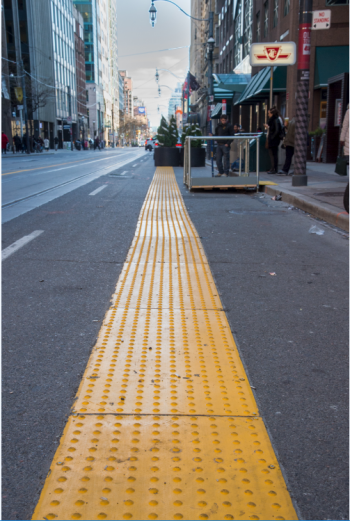
The King Street Transit Priority Corridor has expanded public space along King Street between Jarvis Street and Bathurst Street. The new public spaces, located in curb lanes, serve a variety of uses, including:
The City is implementing an interim build out of public realm infrastructure that will remain in place until permanent streetscape reconstruction is completed.
Based on the feedback received from the previously installed two raised transit-stop platforms on King Street at Portland Street (existing) and Peter Street (temporarily removed for adjacent development construction), six new TTC stop locations have been identified for installation by end of 2024.
The City is working on the design of mid-term, less temporary build out of the public realm on sections of King Street between Jarvis Street and Church Street; and between Portland Street and Bathurst Street. It is currently planned to be completed in 2025.
It is expected to include replacing existing wooden patios and formalizing the existing curb side activities along these two sections. This will improve drainage and snow removal, reduce periodic maintenance and replacement of weathered wood.
The City is working with developers from various development sites along King Street to implement public realm improvements around their construction sites, including sidewalk and boulevard expansion, tree planting, seating and construction of raised transit stop platforms for streetcars (if in the vicinity) as part of the development application reviews.
Temporary parklets are creative structures that encourage people to gather, sit and enjoy their surroundings. They are an economical and innovative solution to provide more space for people in areas that have limited sidewalk space.

The City developed the CaféTO strategy for the pilot to provide a unique economic opportunity for businesses and further beautify the area.
Permitted curb lane cafes within the King Street Transit Priority corridor are unique and are permitted to operate year-round. All of the curb lane cafes within the corridor must adhere to current CaféTO program standards, including cycling offsets and accessibility requirements.

Planters enhance the street, demarcate the ends of the TTC passenger waiting areas, beautify and delineate the public spaces (parklets and patios). These planters are maintained and periodically replanted in coordination with the respective BIAs and adjacent businesses.

Two raised transit stop platforms had previously been installed on King Street at Portland Street and Peter Street. The stop at Peter Street was removed to facilitate construction activities at the adjacent development.
The platforms are the first for a Canadian city and an international best practice at transit stops. They help improve safety for people cycling, driving and those using transit along King Street, by:
These platforms are constructed using temporary, yet durable material and can be easily assembled and installed on site. They can be simpler to integrate with utilities or any impending development and/or construction projects and can be installed faster than traditional construction methods.
The cycling throughways are integrated with the raised transit stop platforms making it safer for people cycling and pedestrians waiting at the transit stops.
Streetcar riders stand behind the wide yellow line (in the wait zone) until a streetcar has stopped at the platform. People cycling can ride over the platform and should be aware of pedestrians at all times.
People cycling wait at the foot of the platform when streetcar riders are boarding/exiting.
To relieve sidewalk congestion, passengers are encouraged to use waiting areas located on the curb lane at TTC stops. These areas are protected by a concrete jersey barrier.
The City sought submissions from digital, visual and graphic artists to create designs for the barriers to animate and beautify the area. Designs were digitally reproduced on two-dimensional vinyl wraps and installed on the barriers.
The winning designs were created by artist Christopher Rouleau, who sought to memorialize King Street’s rich history in a contemporary style.

Yellow tactile truncated dome mats are placed on the road at TTC stops alerting people with low vision or no vision of potential hazards, such as moving vehicles and people cycling.

AODA compliant ramps enable access to the protected passenger waiting areas.